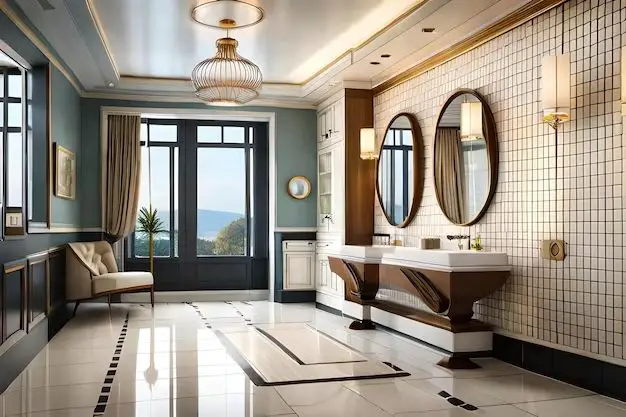Putting a fireplace in the bathroom may seem like an unusual idea, but it is something that some homeowners have considered. There are a few factors to weigh when deciding if a fireplace can go in the bathroom.
Page Contents
Safety Concerns
One of the biggest concerns with putting a fireplace in the bathroom is safety. Bathrooms have lots of water sources from the shower, tub, and sink. Combining water and fire can be extremely dangerous. Additionally, bathrooms are often smaller, enclosed spaces. This means if a fire were to occur, it could quickly fill the room with smoke and become deadly. Proper ventilation is key in bathrooms with fireplaces.
Another safety concern is the materials used in the bathroom. Many bathrooms contain flammable materials like towels, toilet paper, and cleaning products. The fire from the fireplace could easily ignite these items and cause a larger fire. Careful planning of where flammable materials are stored is necessary.
Gas fireplaces also bring up some specific safety concerns. Gas leaks are a danger, so gas fireplaces need routine inspections. Proper ventilation is also critical to prevent carbon monoxide poisoning. Additionally, bathroom fans need a special rating to be able to handle exhaust from a gas fireplace.
Building Codes
Most building codes prohibit putting fireplaces in bathrooms. This is due to the safety concerns around combining open flames with the moisture present in bathrooms. Building inspectors will look for proper clearance between the fireplace and any shower or tub. They will also check that the fireplace meets all ventilation requirements.
Some building codes may allow fireplaces in large master bathrooms. These bathrooms are generally a minimum of 50 square feet and have adequate ventilation. Local building codes dictate the specific requirements for allowing fireplaces in bathrooms.
Ventilation Requirements
Proper ventilation is critical for a bathroom with a fireplace. Bathrooms need ventilation systems to remove moisture and prevent mold growth. Ventilation is even more important when a fireplace is present. The fireplace needs ventilation above it to properly exhaust smoke and fumes. This often requires installing a special chimney vent in the bathroom ceiling.
Bathroom exhaust fans also need to be sized to account for the fireplace. Standard bathroom fans are not enough – a fireplace-rated fan is needed. This fan must be able to remove all smoke in the case of a malfunction with the fireplace. Many building codes require operating the bathroom exhaust fan whenever the fireplace is in use.
Moisture Concerns
Bathrooms contain a lot of moisture from showers and baths. This moisture can damage many building materials over time. Wood-burning fireplaces are especially susceptible to damage from moisture. The moisture can warp and deteriorate the wood over time. Careful maintenance and ventilation is required to prevent moisture damage to a wood-burning fireplace.
Gas fireplaces are less susceptible to moisture damage. However, the drywall and finishing materials around the fireplace still need protection. Bathrooms with fireplaces need moisture-resistant drywall and tile. Occupants also need to use bathroom exhaust fans regularly when showering to remove moisture.
Aesthetic Design
Fireplaces can serve as elegant focal points in bathrooms. As bathrooms trend toward spa-like spaces, fireplaces become attractive design features. Materials like stone and tile complement the bathroom aesthetic. Built-in fireplaces on a wall or freestanding fireplaces can work in larger bathrooms.
Fireplaces with clean-face designs are popular in bathrooms. This allows for easy cleaning and a modern look. Installing the fireplace on an interior wall also hides the venting from exterior view. If the flu is enclosed, the fireplace appears like a seamless part of the bathroom wall.
Heating Ability
While fireplaces can add heat to a bathroom, they are generally not adequate as the sole heat source. Bathrooms are small, wet spaces that can be drafty. This makes it difficult for a fireplace to heat the entire space. Supplemental heating is usually needed for full comfort.
Radiant wall heaters that use hydronic pipes or electric wires are a good pairing with bathroom fireplaces. The fireplace provides some warmth, while the radiant heaters give complete heating coverage. This combination can make a bathroom with a fireplace quite cozy.
Installation Cost
Converting an existing wood-burning fireplace to gas costs $2,500 to $5,000 on average. Installing a new gas fireplace in a bathroom runs $4,000 to $9,000. Wood-burning fireplace installation is $6,000 to $12,000. The high end of the range applies to more elaborate designs with stonework.
Venting costs also impact the total fireplace installation price. Venting a new chimney through the roof averages $3,000 to $6,000. Venting through a side wall is cheaper at $1,500 to $3,000. Any finishing work around the fireplace adds more to the total cost.
Maintenance Requirements
Fireplaces in bathrooms require diligent maintenance. Gas fireplaces need annual inspections to check for leaks or malfunctions. The chimney flu also needs annual cleaning to prevent buildup. Hiring a chimney sweep costs $100 to $300 per cleaning.
Repainting or resealing the surfaces around the fireplace may be needed every 2 to 3 years. Bathroom moisture can wear down paint and grout over time. Monitoring the area for any signs of damage or mold growth is important.
Alternatives to Consider
There are a few options to get a similar look and feel as a fireplace without the risks:
- Decorative fireplace that does not generate heat
- Electric fireplace insert or wall-mounted unit
- Radiant wall heating system
- Sauna for dry heat
- Jacuzzi tub for a spa-like relaxation space
These options can provide a focal point and heat source without venting actual flames in the bathroom. They are often safer and easier to install than real fireplaces.
Conclusion
Installing a fireplace in a bathroom is possible but requires careful planning. Safety issues, building codes, ventilation, moisture control, and maintenance must all be addressed. Fireplaces can create an elegant, spa-like atmosphere but also introduce risks with open flames and water being present. Following building codes and working with experienced professionals is essential to make sure a bathroom fireplace is done properly.
